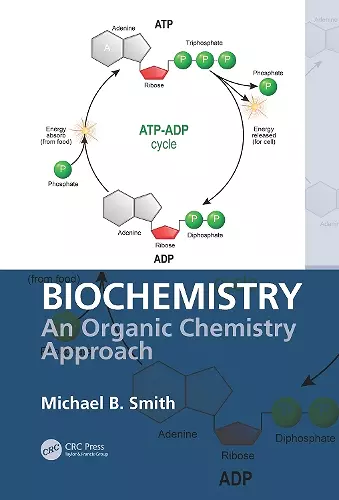Biochemistry
An Organic Chemistry Approach
Format:Hardback
Publisher:Taylor & Francis Inc
Published:14th May '20
Currently unavailable, and unfortunately no date known when it will be back
This hardback is available in another edition too:
- Paperback£110.00(9780815366454)

“There is a continuing demand for up to date organic & bio-organic chemistry undergraduate textbooks. This well planned text builds upon a successful existing work and adds content relevant to biomolecules and biological activity”.
-Professor Philip Page, Emeritus Professor, School of Chemistry University of East Anglia, UK
“Introduces the key concepts of organic chemistry in a succinct and clear way”.
-Andre Cobb, KCL, UK
Reactions in biochemistry can be explained by an understanding of fundamental organic chemistry principles and reactions. This paradigm is extended to biochemical principles and to myriad biomolecules.
Biochemistry: An Organic Chemistry Approach provides a framework for understanding various topics of biochemistry, including the chemical behavior of biomolecules, enzyme activity, and more. It goes beyond mere memorization. Using several techniques to develop a relational understanding, including homework, this text helps students fully grasp and better correlate the essential organic chemistry concepts with those concepts at the root of biochemistry. The goal is to better understand the fundamental principles of biochemistry.
Features:
- Presents a review chapter of fundamental organic chemistry principles and reactions.
- Presents and explains the fundamental principles of biochemistry using principles and common reactions of organic chemistry.
- Discusses enzymes, proteins, fatty acids, lipids, vitamins, hormones, nucleic acids and other biomolecules by comparing and contrasting them with the organic chemistry reactions that constitute the foundation of these classes of biomolecules.
- Discusses the organic synthesis and reactions of amino acids, carbohydrates, nucleic acids and other biomolecules. <
Describing an interesting way to teach biochemistry, especially in conjunction with organic chemistry, this textbook should find application at many schools. The first of 15 chapters is a review of the fundamentals of an organic chemistry course, but a full course may be necessary for beginners to benefit from further study. Subsequent discussion of organic reactions and mechanisms will be more meaningful for students already familiar with organic chemistry basics. Chapter 2 describes acid-base chemistry, elimination reactions, and the importance of water in chemistry. Chapter 3 discusses nucleophilic substitution; chapter 4 explains free radical reactions. Subsequent chapters discuss, respectively, dienes, conjugated systems, sigmatropic rearrangements, enols and enolate reactions, enzymes, enzyme kinetics, carboxylic acid and derivatives, lipids, aromatic chemistry, heteroaromatic chemistry, organometallic compounds, biologically relevant metals, chelating reagents, amino acids, peptides, proteins, carbohydrates and derivatives, glycosides, nucleosides, nucleotides, DNA, and RNA. Each chapter concludes with homework questions; finally, chapter 16 includes the answers to the questions. Common abbreviations are listed at the beginning of the book, and several compounds and functional groups also have line formulas or partial structures shown. The book can be used by teachers and students of chemistry, and will be useful for all chemists as a review.
--R. E. Buntrock, independent scholar
Summing Up: Recommended. Lower- and upper-division undergraduates. Graduate students, faculty, and professionals.
ISBN: 9780815367130
Dimensions: unknown
Weight: 993g
472 pages